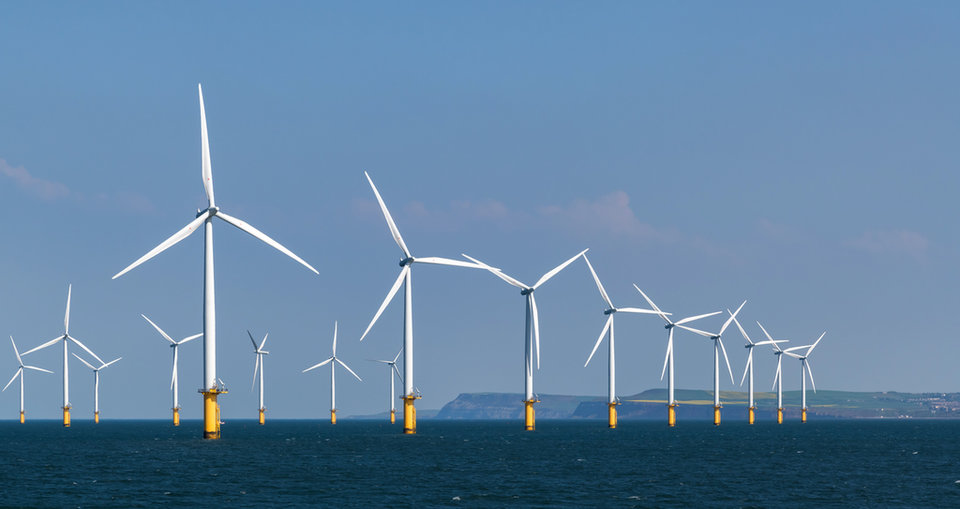EnviroNment
Aviation and wind farms:
working together for a safer future
As the UK looks towards a renewable future, wind is set to play a key role. There remain some challenges though, not least the impact aviation and wind facilities can have on each other. Andrew Tunnicliffe speaks with Alicia Green of RenewableUK and Mark Balsdon of NATS about how the industries can work together.
Can the wind and aviation sectors coexist? It’s a question that has led to collaboration at all levels, but it wasn’t always that way. “Back in 2000, wind farm developers and their plans were a big risk to our operations, as ours were to theirs,” explains NATS head of airlines and airspace user’s customer management Mark Balsdon.
“We objected to their presence because turbines interfered with our radars and other infrastructure, with the obvious potential impact on safety. They objected to our reluctance to agree to conditions that would secure planning permission.”
Balsdon says it was then the aviation industry realised that, to support the government’s drive for green energy, it would have to be “proactive in finding ways to mitigate the impact”. The renewable industry also recognises the importance of collaboration, says RenewableUK policy analyst Alicia Green. “For many years, RenewableUK has worked with other aviation stakeholders… There is a collective acknowledgement that it's prudent for the aviation and wind industries to work closely together.”
RenewableUK policy analyst Alicia Green. Image: Renewable UK, NATS

The coexistence of the aviation and the wind sectors has been challenging. In the UK, both are critical to economic growth, and will no doubt be more so in a post-pandemic era. However, the positioning of aviation infrastructures such as airports and helipads, and wind infrastructures such as wind farms and turbines, will continue to be a challenge.
Among the issues are the turbulence wind farms can create, how their operation can affect radar and how they can simply “be in the way”, a representative of aviation consultancy TO70 wrote in a blog post.
“Wind turbines can cause radar interference whereby the blades appear as ‘clutter’ on radar screens and can be mistaken for aircraft,” says Balsdon. Accepting this is not the most suitable solution, he says the relied-upon mitigation has traditionally been “blanking” – covering the part of the radar screen where the turbine is. “That’s clearly not an ideal or long-term solution,” he accepts. “We have also looked at changing airspace design, but again that’s not always possible.”

NATS head of airlines and airspace user’s customer management Mark Balsdon. Image: Renewable UK, NATS
Image:
Collaboration is key
It is for that reason working together is so critical, to all parties. “We take a strategic approach to coexisting and resolving possible conflicts; advising wind farm developers on our experience of what does and doesn’t work, as well as tailoring solutions to meet their needs,” Balsdon adds.
For its part, the renewable sector has also fostered an open and collaborative approach. In the UK, RenewableUK has been working with the Ministry of Defence, Department for Transport, Department for Business, Energy and Industrial Strategy (BEIS), the Scottish Government, the Civil Aviation Authority, NATS, the Airport Operators Association, the General Aviation Awareness Council, and The Crown Estate for many years.

A wind farm off the north coast of the UK.
“The dialogues have been going on for many years,” says Green. "Government and the aviation authorities recognise the crucial need to develop renewable energy to tackle climate change, and the wind industry recognises the need for technical solutions so that the presence of turbines does not have any impact on aviation radar.”
She believes a proactive and collaborative approach has resulted in the identification of opportunities and solutions which enable mitigation measures to be implemented in a significant number of situations, including defence radar and low flying operations. However, she warns there is not a “one-size-fits-all” solution, given the unique operational environment of air infrastructure.
Continued collaboration is crucial if concerns are to be addressed. “We’ve made especially good progress over the past decade with high-tech systems installed in various locations, each tailor-made to each airport, to mitigate any effect that wind farms could have on radar,” Green explains.
The wind industry recognises the need for technical solutions so that the presence of turbines does not have any impact on radars
More work still to do
Over the past five years, NATS has been working with radar manufacturers on systems to mitigate the effect of turbines. “We’re now seeing those being adopted and installed, such as at Edinburgh Airport where its new Terma radar can mitigate against the impact of the Tormywheel Wind Farm, allowing for the release of 34 MW,” says Balsdon. Similar radars are now in use at seven other UK airports and NATS is looking to install a new 3D Indra radar it hopes will allow for more generating capacity to be produced.
However, Green says there are still some areas where aviation issues make it impossible for the wind sector to maximise the UK’s capacity to generate clean energy. “We will continue to work towards even more sophisticated technological solutions… This will allow us to make the most of the UK’s excellent wind resources and ensure that the aviation sector continues to operate safely and smoothly throughout the UK,” Green says.

British Airways aircraft in storage at Glasgow Airport, which recently installed a new radar to help mitigate the impact of the Kype Muir Wind Farm near Strathaven, Scotland. Image: Liner / Shutterstock.com
Given the UK Government’s decision to lift the block on new wind farms, the industry looks set to increase its profile in the coming years. This renewed involvement means all parties must work harder than ever to consolidate an uninhibited coexistence.
Speaking about the UK Offshore Wind Sector Deal announced in March 2019, Green said one of the key parts was a renewed commitment to work collaboratively on strategic deployment issues, including aviation and radar. The deal established targets to ensure the UK benefits from the ongoing deployment of offshore capacity.
Green says the deal has already resulted in an aviation-focused workstream to develop a longer-term strategy for coexistence. “RenewableUK is actively involved within these workstreams, as well as having our own Aviation Working Group for our member companies,” she adds.
We will continue to work towards even more sophisticated technological solutions
Working together to address the issues
“It’s in all our interests to work closely on this. We have a positive and longstanding relationship with all the stakeholders and there is a strong spirit of cooperation among us,” Green continues.
Balsdon says those relationships have helped break down barriers and develop a sense of shared ownership and responsibility. “We’ve partnered with radar manufacturers to develop modifications that almost eliminate false tracks and increase detection of aircraft where there are large concentrations of wind turbines,” he adds. “As a result, we’ve helped the industry release gigawatts of renewable energy and are making successful co-existence a reality.”
As the Covid-19 pandemic continues to sweep the world, so too will an easing of restrictions and with that, more travel. With industries and governments working together, and as new technologies come to fruition, the solutions could be even more impactful. However, the need to cooperate will never have been more important.
“Everyone wants to ensure that safety comes first, so the renewable energy industry and aviation industry work together in a spirit of cooperation so that we can both go about our work with full confidence in each other within a government-led framework,” concludes Green.
“Both parties have important roles to play,” Balsdon adds. “Ours is to keep the skies safe while the renewable industry needs to help us tackle the immense challenge of climate change. By working together, we can both meet those aims.”
The renewable energy industry and the aviation industry work together in a spirit of cooperation